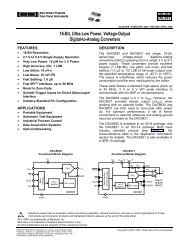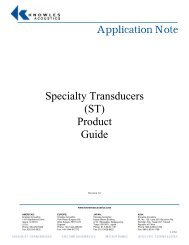AD7714* 3 V/5 V, CMOS, 500 µA Signal Conditioning ADC - dreamm
AD7714* 3 V/5 V, CMOS, 500 µA Signal Conditioning ADC - dreamm
AD7714* 3 V/5 V, CMOS, 500 µA Signal Conditioning ADC - dreamm
You also want an ePaper? Increase the reach of your titles
YUMPU automatically turns print PDFs into web optimized ePapers that Google loves.
AD7714<br />
In addition, the digital filter does not provide any rejection at<br />
integer multiples of the digital filter’s sample frequency. However,<br />
the input sampling on the part provides attenuation at<br />
multiples of the digital filter’s sampling frequency so that the<br />
unattenuated bands actually occur around multiples of the input<br />
sampling frequency fs (as defined in Table XIV). Thus, the<br />
unattenuated bands occur at n × fs (where n = 1, 2, 3. . .). At<br />
these frequencies, there are frequency bands, ±f 3 dB wide (f 3 dB is<br />
the cutoff frequency of the digital filter) at either side where<br />
noise passes unattenuated to the output.<br />
Filter Characteristics<br />
The AD7714’s digital filter is a low-pass filter with a (sinx/x) 3<br />
response (also called sinc 3 ). The transfer function for this filter<br />
is described in the z-domain by:<br />
⎡<br />
H(z) =<br />
1 × 1 − Z −N ⎤<br />
⎢<br />
⎥<br />
⎢<br />
⎣ N 1 − Z −1 ⎥<br />
⎦<br />
and in the frequency domain by:<br />
H( f ) = 1 Sin (N.π. f fs)<br />
×<br />
N Sin (π. f fs)<br />
Figure 4 shows the filter frequency response for a cutoff<br />
frequency of 2.62 Hz which corresponds to a first filter notch<br />
frequency of 10 Hz. The plot is shown from dc to 65 Hz.<br />
This response is repeated at either side of the input sampling<br />
frequency and at either side of multiples of the input sampling<br />
frequency.<br />
GAIN – dB<br />
0<br />
–20<br />
–40<br />
–60<br />
–80<br />
–100<br />
–120<br />
–140<br />
–160<br />
–180<br />
–200<br />
–220<br />
–240<br />
0<br />
10 20 30 40<br />
FREQUENCY – Hz<br />
Figure 4. Frequency Response of AD7714 Filter<br />
The response of the filter is similar to that of an averaging filter<br />
but with a sharper roll-off. The output rate for the digital filter<br />
corresponds with the positioning of the first notch of the filter’s<br />
frequency response. Thus, for the plot of Figure 4 where the<br />
output rate is 10 Hz, the first notch of the filter is at 10 Hz. The<br />
notches of this (sinx/x) 3 filter are repeated at multiples of the<br />
first notch. The filter provides attenuation of better than 100 dB<br />
at these notches. For the example given, if the first notch is at<br />
10 Hz, there will be notches (and hence >100 dB rejection) at<br />
both 50 Hz and 60 Hz.<br />
The cutoff frequency of the digital filter is determined by the<br />
value loaded to bits FS0 to FS11 in the Filter High and Filter<br />
Low Registers. Programming a different cutoff frequency via<br />
3<br />
50<br />
3<br />
60<br />
FS0 – FS11 does not alter the profile of the filter response; it<br />
changes the frequency of the notches as outlined in the Filter<br />
Registers section. The output update and first notch correspond<br />
and are determined by the relationship:<br />
Output Rate = f CLK IN /(N.128)<br />
where N is the decimal equivalent of the word loaded to the<br />
FS0 to FS11 bits of the Filter Registers<br />
while the –3 dB frequency is determined by the relationship:<br />
–3 dB frequency = 0.262 × filter first notch frequency<br />
The filter provides a linear phase response with a group delay<br />
determined by:<br />
Group Delay = –3π.(N.f/f MOD )<br />
where N is the decimal equivalent of the word loaded to the<br />
FS0 to FS11 bits of the Filter Registers and f MOD = f CLK IN /128.<br />
Since the AD7714 contains this on-chip, low-pass filtering,<br />
there is a settling time associated with step function inputs and<br />
data on the output will be invalid after a step change until the<br />
settling time has elapsed. The settling time depends upon the<br />
output rate chosen for the filter. The settling time of the filter<br />
to a full-scale step input can be up to 4 times the output data<br />
period. For a synchronized step input (using the SYNC or<br />
FSYNC functions) the settling time is 3 times the output data<br />
period. When changing channels on the part, the change from<br />
one channel to the other is synchronized so the output settling<br />
time is also 3 times the output data period. Thus, in switching<br />
between channels, the output data register is not updated until<br />
the settling time of the filter has elapsed.<br />
Post-Filtering<br />
The on-chip modulator provides samples at a 19.2 kHz output<br />
rate with f CLK IN at 2.4576 MHz. The on-chip digital filter decimates<br />
these samples to provide data at an output rate which<br />
corresponds to the programmed output rate of the filter. Since<br />
the output data rate is higher than the Nyquist criterion, the<br />
output rate for a given bandwidth will satisfy most application<br />
requirements. However, there may be some applications which<br />
require a higher data rate for a given bandwidth and noise performance.<br />
Applications which need this higher data rate will<br />
require some post-filtering following the part’s digital filter.<br />
For example, if the required bandwidth is 7.86 Hz but the<br />
required update rate is 100 Hz, the data can be taken from the<br />
AD7714 at the 100 Hz rate giving a –3 dB bandwidth of<br />
26.2 Hz. Post-filtering can be applied to this to reduce the<br />
bandwidth and output noise, to the 7.86 Hz bandwidth level,<br />
while maintaining an output rate of 100 Hz.<br />
Post-filtering can also be used to reduce the output noise from<br />
the device for bandwidths below 1.26 Hz. At a gain of 128 and<br />
a bandwidth of 1.26 Hz, the output rms noise is 140 nV. This<br />
is essentially device noise or white noise and since the input is<br />
chopped, the noise has a primarily flat frequency response. By<br />
reducing the bandwidth below 1.26 Hz, the noise in the resultant<br />
passband can be reduced. A reduction in bandwidth by a<br />
factor of 2 results in a reduction of approximately 1.25 in the<br />
output rms noise. This additional filtering will result in a<br />
longer settling time.<br />
–20–<br />
REV. B















